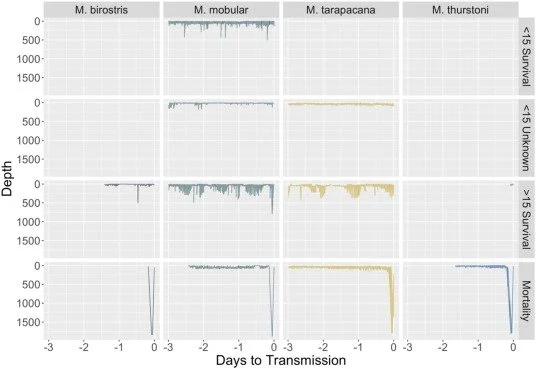Get them off the deck: Straightforward interventions increase post-release survival rates of manta and devil rays in tuna purse seine fisheries
September 2024
Joshua D. Stewart, Melissa R. Cronin, Erick Largacha, Nerea Lezama-Ochoa, Jon Lopez, Martin Hall, Melanie Hutchinson, Emma G. Jones, Malcolm Francis, Maitane Grande, Jefferson Murua, Vanessa Rojo & Salvador J. Jorgensen
Keywords: Mobulid • Post-release mortality • Conservation • Mitigation • RFMOs • Best practices





Summary: Bycatch in commercial tuna fisheries poses a major threat to manta and devil rays (mobulids), which have seen population declines due to both targeted and incidental capture. Many countries and fisheries organisations have banned the retention of mobulids and mandated handling and release procedures to improve their survival. A study using satellite tags on four species (M. birostris, M. mobular, M. tarapacana, M. thurstoni) found that survival rates varied by species, with handling time and capture method impacting survivorship. Improved handling practices can increase survival rates, helping inform conservation efforts for these vulnerable species.
Abstract
“Bycatch remains a major challenge in commercial fisheries, with large numbers of threatened species impacted by incidental capture. One of the most vulnerable bycatch groups in global tuna fisheries are the manta and devil rays (mobulids), which have experienced significant population declines in response to both targeted and incidental capture. The retention of mobulids has been banned by many countries and Regional Fisheries Management Organizations (RFMOs), but major knowledge gaps exist in the group's survival rates following release after incidental capture. Mobulids are accidentally captured in purse seine fisheries, and in recent years, many RFMOs have mandated handling and release procedures for mobulids in an effort to maximize survivorship and reduce impacts of fishery bycatch. We synthesize data from four empirical studies using satellite tags (n = 89) to estimate survival rates of four species of mobulids (Mobula birostris, M. mobular, M. tarapacana and M. thurstoni) released from tuna purse seine vessels in three global regions. We directly estimate the effects of intrinsic, environmental, and operational factors, and handling and release methods on mobulid survival rates. We found a significant negative effect of time spent on deck; likely negative effects of the brailer number in which a ray was brought out of the sacked net, and remaining in the sacked purse seine net until after brailing was complete; and likely positive effects of being captured in a floating object set and body size on survival probability. The observed survival rates of mobulids with known fates were 50 % for M. birostris, 74.2 % for M. mobular, 33.3 % for M. tarapacana, and 20 % for. M thurstoni. The median predicted survival probability under optimal handling conditions was 83.7 % for M. birostris, 95.3 % for M. mobular, 82.2 % for M. tarapacana, and 53.7 % for M. thurstoni. These empirical estimates can improve handling methods and vulnerability assessments of these endangered species in global fisheries.”
Infographic
Infographic by Jasmine Corbett
Author Affiliations
Ocean Ecology Lab, Marine Mammal Institute, Department of Fisheries, Wildlife and Conservation Sciences, Oregon State University
The Manta Trust
Mobula Conservation
Duke University Marine Lab, Nicholas School of the Environment
Institute of Marine Science, University of California Santa Cruz
Ecosystem Science Division, Southwest Fisheries Science Center, NOAA Fisheries
Inter-American Tropical Tuna Commission, Ecosystem and Bycatch Program
redCID (Network for the Study of Incidental Captures and Discards)
National Institute of Water and Atmospheric Research (NIWA), Auckland
National Institute of Water and Atmospheric Research (NIWA), Wellington
AZTI, Herrera Kaia
Instituto Español de Oceanografía, Centro Oceanográfico de Canarias
California State University at Monterey Bay
Formerly: Monterey Bay Aquarium
Formerly: Inter-American Tropical Tuna Commission Field Office, Manta, Ecuador
Funding
Monterey Bay Aquarium
Save Our Seas Foundation
The International Seafood Sustainability Foundation
OPAGAC
Basque Government
The Department of Conservation
Contribution towards the Manta Trust's Strategic Plan
Goal 2: Strategic Objective 2.1: Relevant RFMOs, fishery collectives, fishing fleets, artisanal fishers, recreational, and subsistence fishers within our geographical focus areas are working towards measures to reduce manta and devil ray capture and bycatch mortality.
Goal 2: Strategic Objective 2.1.1: Effective means to reduce manta and devil ray bycatch and mortality have been identifed.
Goal 2: Strategic Objective 2.1.2: Relevant fishers have the knowledge and skills to reduce manta and devil ray capture and mortality.


